
List of festivals in Nepal
Encyclopedia

Nepal
Nepal , officially the Federal Democratic Republic of Nepal, is a landlocked sovereign state located in South Asia. It is located in the Himalayas and bordered to the north by the People's Republic of China, and to the south, east, and west by the Republic of India...
. As a predominantly Hindu
Hinduism
Hinduism is the predominant and indigenous religious tradition of the Indian Subcontinent. Hinduism is known to its followers as , amongst many other expressions...
and Buddhist
Buddhism
Buddhism is a religion and philosophy encompassing a variety of traditions, beliefs and practices, largely based on teachings attributed to Siddhartha Gautama, commonly known as the Buddha . The Buddha lived and taught in the northeastern Indian subcontinent some time between the 6th and 4th...
nation, many of the festivals in Nepal are religious ones.
The Machchhindra Jatra
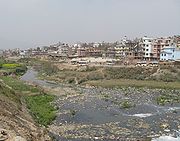
Bagmati
The Bagmati River is a river of Nepal and India. It flows through the Kathmandu valley and is the river separating Kathmandu from Lalitpur. It is considered a holy river both by Hindus and Buddhists...
. It is then taken to Patan, mounted on a large rath or car and a shrine is placed with carvings and flowers. The whole procession may take up to a week and the idol of Machchhindra is displayed in Patan for a month, before taken back to the Bagmati and placed back in its home temple in Kathmandu. The day that it is returned is referred to as Gudrijhar and the blanket of the idol is symbolically shaken to reveal its emptiness to represent contentment, despite poverty.
Bajra Jagini Jatra
Bajra Jagini was originally celebrated by Buddhists but is also celebrated by Hindus on the 3rd of Baisakh. Her temple, Kharg Jogini, is found at Manichur mountain, near SankhuSankhu
Sankhu is a village development committee in Kathmandu District in the Bagmati Zone of central Nepal. At the time of the 1991 Nepal census it had a population of 2097 living in 353 individual households....
. During the week long festival, a fire is burned in the vicinity of the temple near an image of a human head. An image of the goddess is placed in a khat (a wooden shrine) and carried through the town by the men.
Siti Jatra
The Siti Jatra takes place on the 21st of Jeth, on the banks of the Vishnumati, between Kathmandu and Simbhunath. The people feast and afterwards divide into two teams to contest a stone throwing competition. The match was once a serious affair and anybody who was knocked down or captured by the other party was sacrificed to the goddess Kankeshwari. In modern times, however. it is a light hearted affair, mostly among the children.Gathia Mogal or Ghanta Karn
This festival refers to the celebration of the expulsion of a Rakshasa or demon from the country, held on the 14th of Sawan. The Newars make a straw figure which they beat and drag around the streets. The figures are burned at sunset.Banra Jatra
The festival is celebrated twice a year, on the 8th of Sawan and the 13th of Bhadon. The Banras, priests of the Newar Buddhists visit each house and receive a small offering of grain or rice to commemorate their ancestors who were not permitted to trade. The Newars decorate their shops and houses with pictures and flowers and the women sit with large baskets of rice and grain to dispense to the Banras.Janai Purnima
The Rakhi Purnima festival takes place on the last day of Sawan and is celebrated by both Buddhists and Hindus. However the Buddhist bathe in sacred streams and visit their temples and the Brahman priests tie an ornamental thread to the wrists of their followers and in return receive gifts. Many pilgrims visit Gosain Than and bathe at the sacred lake.Nag Panchami
Nag Panchani takes place on the 5th of Sawan to commemorate the battle between NagNag
Nag may refer to:* Nag Missile, a third generation "fire and forget" anti-tank missile* Nag, a horse that is of low quality.* Nag, a male cobra in Rudyard Kipling's Rikki-Tikki-Tavi* Nag, a multi user tasklist manager included in Horde...
and Garur
Garur
Garur is a town in the Bageshwar district of the state of Uttarakhand, India.-Geography and demographics:Nearby places include Kausani, Baijnath, Gwaldam and Bageshwar....
. The stone image of Garur at Changu Narayan is said to perspire during the festival and priests are sent to wipe the perspiration off with a handkerchief. They later present it to the king and water is used to make it into a snake bite remedy, despite the fact that there are few snakes inhabiting Nepal.
Janmashtami
Janmashtami is celebrated on the 8th of Bhadon, in memory of KrishnaKrishna
Krishna is a central figure of Hinduism and is traditionally attributed the authorship of the Bhagavad Gita. He is the supreme Being and considered in some monotheistic traditions as an Avatar of Vishnu...
. Shops and houses are adorned in celebration.
Gai Jatra
This entirely Newar festival is held on the 1st day of Bhadon. Newars who have lost loved ones during the year traditionally disguised themselves as cows and danced around the palace of the king. However, in modern times, the ceremony is performed only as a masked dance with the singing of songs.Bagh Jatra
This festival takes place on the 2nd of Bhadon. Dancers once dressed up in tiger costumes but today it is merely a repetition of the Gai Jatra festival.Indra Jatra
The Indra Jatra festival begins on the 26th of Bhadon and lasts for eight days. On the first day a lofty wooden post is erected before the king's palace and dancers from all across Nepal perform with masks. If an earthquake ever occurred on the opening day of the festival this was considered a bad omen and the festival would have to be restarted. On the third day, young virgins are brought before the king and worshipped and then carried through Kathmandu, mounted on oars.Dashain
This festival takes place on the 26th of Kuar. It lasts for 10 days and buffaloes and goats are sacrificed. On the initial festival day, the Brahmans sow barleyBarley
Barley is a major cereal grain, a member of the grass family. It serves as a major animal fodder, as a base malt for beer and certain distilled beverages, and as a component of various health foods...
at the place where they worship and ritualistically sprinkle it with sacred water on a daily basis. On the tenth day they pull it up and present it in bunches to their followers.
Deepawali
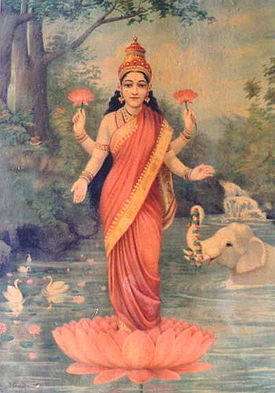
Lakshmi
Lakshmi or Lakumi is the Hindu goddess of wealth, prosperity , light, wisdom, fortune, fertility, generosity and courage; and the embodiment of beauty, grace and charm. Representations of Lakshmi are also found in Jain monuments...
, the goddess of wealth. People illuminate their houses and gambling is permitted for three days and nights. During the celebrations gamblers are found in the streets and some gamblers are known to make extreme bets such as staking their own wives and even their own hands.
Khicha Puja or Gai Puja/Sa Paru
Khicha Puja is a Newar festival held on the 15th of Kartik in late autumn as part of the Tihar Festival. Dog, crows and cows are especially prominent during this festival and dogs are commonly seen with wreaths of flowers around their necks. Crows are worshipped by offerings of sweets and dishes. The cawing of the crows symbolises sadness and grief in the Hindu mythologyHindu mythology
Hindu religious literature is the large body of traditional narratives related to Hinduism, notably as contained in Sanskrit literature, such as the Sanskrit epics and the Puranas. As such, it is a subset of Nepali and Indian culture...
, so the devotees offer the crows food to avert grief and deaths in their homes. Cows are commonly celebrated on the third day of Tihar, as they are regarded as the mothers of the universe in Hinduism, where after weaning by the birth mother, the cow acts as the surrogate mother to humans, providing milk for the rest of the human life. A tika is placed on the forehead of the cow and a flower garland is placed on the neck.The cow festival is known as Gai Puja in Nepali but commonly referred to as Sa Paru
Sa Paru
Sā Pāru is a festival celebrated chiefly in Nepal by the Newars. The festival commemorates the death of people during the span of a year.See also: Gaijatra...
.
Bhai Tika
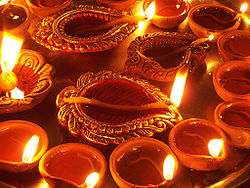
Bala Chaturdasi or Satbyu

Pashupati
Pashupati , "Lord of cattle", is an epithet of the Hindu god Shiva. In Vedic times it was used as an epithet of Rudra. The Rigveda has the related pashupa "protector of cattle" as a name of Pushan. The Pashupatinath Temple is the most important Hindu shrine for all Hindus in Nepal and also for many...
to scatter an offering of rice, vegetables and sweetmeats.
Kartik Purnima
On the first day of the month of Kartik, many women go to the temple of Pashupati. There they remain for an entire month, fasting and drinking only water. Some women have died during the fasting but the majority generally survive and on the last day of the month, known as the purnima, the night is spent rejoicing the success of the fasting by singing and dancing into the night.Ganesh Chauth
The Ganesh Chauth festival is held on the 4th of Magh, in honor of Ganesh, the god of wisdom. The day is spent fasting and worshipping and in ended by feasting into the night.Maghe Sankranti
Maghe sankranti is observed in the month of January on the first day of the month of MaghMagh
Magh may refer to:* Magi* Magh people, the Arakanese nationalities known in Bengal as Maghs* Maagha, a month in Hindu calendar* Magh * Magh * Magh * Magha , author of Shishupala Vadha...
, bringing an end to the ill-omened month of Poush
Poush
Poush is the 9th month of both the Bangla calendar and the Nepali Calendar. It overlaps December and January of the Gregorian calendar. It is the first month of the winter season....
when all religious ceremonies are forbidden.On this day, the sun leaves its southernmost position and takes off for its northward journey, so Maghe Sankranti is similar to solstice
Solstice
A solstice is an astronomical event that happens twice each year when the Sun's apparent position in the sky, as viewed from Earth, reaches its northernmost or southernmost extremes...
festivals in many other traditions. People participate in holy bathing in this festival and auspicious foods like laddoo, ghee
Ghee
Ghee is a class of clarified butter that originated in South Asia and is commonly used in South Asian cuisine....
, sweet potato
Sweet potato
The sweet potato is a dicotyledonous plant that belongs to the family Convolvulaceae. Its large, starchy, sweet-tasting, tuberous roots are an important root vegetable. The young leaves and shoots are sometimes eaten as greens. Of the approximately 50 genera and more than 1,000 species of...
es etc are distributed. The mother of the house wishes good health to all family members.
According to Mahabharata
Mahabharata
The Mahabharata is one of the two major Sanskrit epics of ancient India and Nepal, the other being the Ramayana. The epic is part of itihasa....
, king Bhisma, who had the power to control his own death, happened to choose to die on the day of Maghe Sakranti. Therefore it is believed that to die on this day might achieve Moksha
Moksha
Within Indian religions, moksha or mukti , literally "release" , is the liberation from samsara and the concomitant suffering involved in being subject to the cycle of repeated death and reincarnation or rebirth.-Origins:It is highly probable that the concept of moksha was first developed in...
, a release from the rebirth cycle.
Basant or Sripanchami
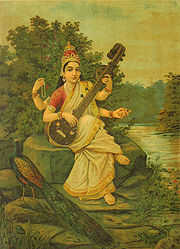
Saraswati
In Hinduism Saraswati , is the goddess of knowledge, music, arts, science and technology. She is the consort of Brahma, also revered as His Shakti....
, the goddess of learning.
Holi
The festival takes place on the last day of PhagunPhalguna
Phalguna is a month of the Hindu calendar. In India's national civil calendar, Phaalgun is the twelfth month of the year, beginning on 20 February and ending on 21 March .In lunar religious calendars, Phaalgun may begin on either the new moon or the full moon...
. In Nepal, a wooden post, known as a chir is adorned with flags and erected in front of the palace. It is burned at night, representing the burning of the body of the old year.
Maghi Purnima
The bathing festival where Newars bathe in the Bagmati River. during Magh. On the last day of the month, bathers are carried in a procession in ornamented dolis, lying on their backs with lighted lamps (known as chirags) on their chests, arms and legs. Other bathers bear earthen water pots on their heads, perforated with straws, through which water seeps down to sprinkle passers by. Traditionally the bathers wear green spectacles to protect their eyes from the sparks of the lamps they are in contact with.Ghoday Jatra
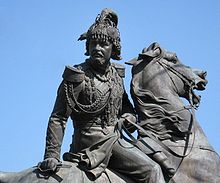
Jang Bahadur
Maharaja Jung Bahadur Rana was a ruler of Nepal and founder of the Rana dynasty of Nepal...
's statue. After the event, gambling is allowed for two days and nights and the festival ends with an illumination of the monument. In 1875, Bahadur's statue and four dragon monuments were moved into a newly built temple in his honor, hence the location of the festival moved.
Limbu festivals
Some festivals may be practiced within ethnic groups in Nepal. Here are notable LimbuLimbu people
The Yakthung or Limbu tribes and clans belong to the Kirati nation or to the Kirat confederation.They are indigenous to the hill and mountainous regions of east Nepal between the Arun and Mechi rivers to as far as Southern Tibet, Bhutan and Sikkim....
festivals:
- Chasok TangnamChasok TangnamChasok Tangnam is the most important of Kirat Limbu festivals. This festival falls on a full moon day of the month of Senchengla or the Mangsir month of Nepali calendar. "Tangnam" simply means festival in Limbu language. Along with the resurgence of Limbu identity, culture and nationalism, Limbus...
- Kakphekwa Tangnam
- Yakwa Tangnam
- Sisekwa Tangnam
- Walihang Tangnam - The Limbu version of the Tihar festival
- Kusang Tangnam
Chhechu
Chhechu is a ceremony of the TamangTamang
The Tamangs are the ancient and original inhabitants of the mountains and plains of the Himalayan regions of Nepal and India. Their ancient capital being Yambu - modern day Kathmandu. They have their own distinct culture, language and religion. Their ancestral domain is popularly known as...
communities that takes place to the northwest of the Kathmandu Valley
Kathmandu Valley
The Kathmandu Valley , located in Nepal, lies at the crossroads of ancient civilizations of Asia, and has at least 130 important monuments, including several places of pilgrimage for the Hindus and the Buddhists. There are seven UNESCO World Heritage Sites within this valley.-Etymology:The city of...
of Nepal over the course of ten days. It contains sportive plays (tsema), exorcism
Exorcism
Exorcism is the religious practice of evicting demons or other spiritual entities from a person or place which they are believed to have possessed...
s, and rituals. There are eleven tsema performed, and three exorcism
Exorcism
Exorcism is the religious practice of evicting demons or other spiritual entities from a person or place which they are believed to have possessed...
s.

